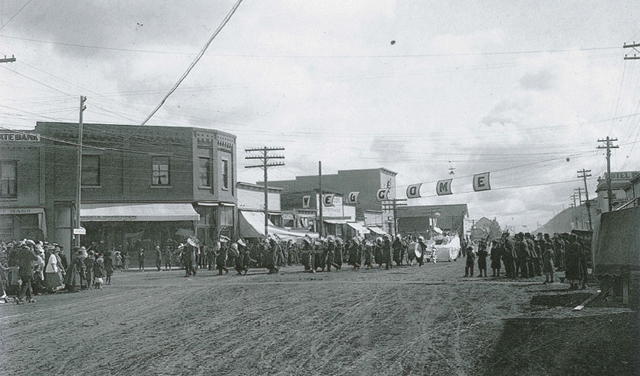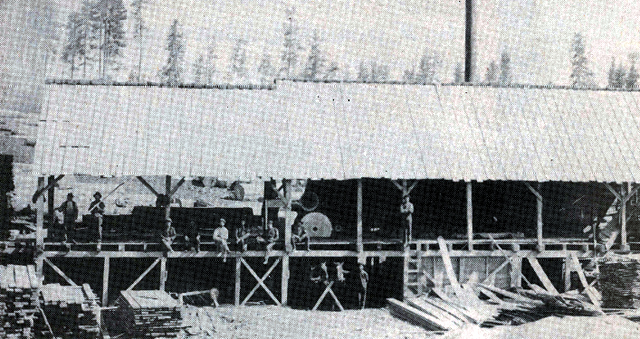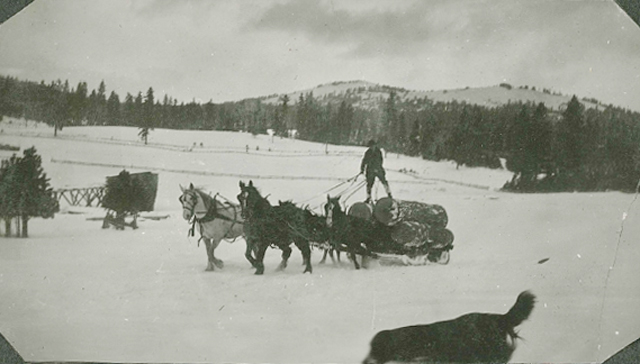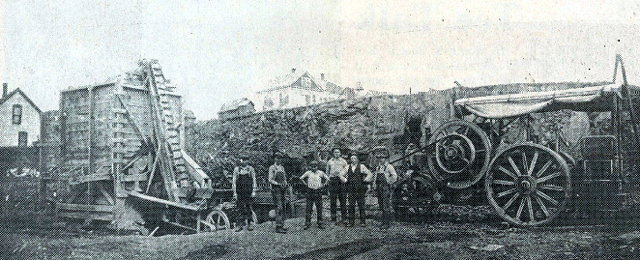| Cottonwood
to celebrate 150th year in 2012, area history included
(Cottonwood history continued from last week) Cottonwood had it’s own “Chicago” fire in July 1908. The fire burnt both sides of Main Street. In a matter of 3 hours, all was lost. Approximately 40 businesses were completely lost. People started to think and plan for a fire department. The people were up to the challenge and in 6 months many of the buildings had been replaced. Two brick yards, one at St. Michael’s Monastery, and one out at the Mader Brickyard were kept busy making bricks for chimney construction and at least two or three of the business places on Main Street were all brick construction. About this time the railroad came to town! The road between Keuterville and Cottonwood was filed by lumber wagons for the rebuilding in Cottonwood and also being shipped elsewhere by rail for all types of construction. Lumber was piled along the tracks near the local milling company for shipment. The John & Joe Hoene Sawmills landed a big lumber contract with Interior Whse. (later called The Farmer’s Union and LGG) to build storage elevators at Fenn, Grangeville, Ferdinand and Cottonwood. The big Shissler Mill at Rustic (last week we mistakenly called this the Schnider Mill) was not rebuilt there putting more pressure on the smaller mills to keep up with the area-wide building boom. At this time new lumber was in big demand for churches, schools, homes, barns and all other means of shelter. With the coming of the railroad, lumber, livestock and other farm products (even milk) were shipped out two and three times a week during the busy time. The Sisters also built housing and school facilities and these buildings would last until they started the big new “Blue Rock” Monastery in about 1920. The public school system started first in this area and was mostly taught by lay teachers. As these first schools operated only two or three months at a time, the same teacher would rotate with the schedules. Soon Cottonwood, Ferdinand and Greencreek had both lay and the Sisters teaching in each area. The first 10 years of the new century brought many new people to the area. Farm implements as well as cars and trucks made a big change in the way we did things. With the coming of more people (and more banks) credit started to loosen up. Up to this time it was cash-trade or self finance. Credit slowly became part of a way of life. Both lenders and borrowers had to learn how to use it properly. Much money would be lost in the next 10 to 15 years after 1910. Elsewhere in town the local doctors, Turner and Blake Truitt were joined by Dr. W. F. Orr and each had their own midwives to help take care of new babies and people who were hurt or otherwise needed medical help. Different locations were used for medical help as in this time frame there was no hospital. Cottonwood became an incorporated village in 1901. Practically the first order of business was to build a jail on Front Street down on the north side of the creek. The bid went to J. Aichlmayer for $82. The building was to be 7 x 14 feet, 6 ½ feet high on the inside, walls of 2x6 spike every 18 inches with 20p spikes, floor and ceiling 2x4 placed on edge and spiked. This jail was burned down by vandals in 1903, replacement cost was $218. Incidentally, a reward of $100 was offered to catch the vandals. Later, with the building of the Community Hall, the replacement jail was moved up on the hill near Hank Lerandeau’s home where it still sets. In the Greencreek and Ferdinand area the first local stores, churches and schools were being built and teachers were being hired. The days of oil lamps and horse drawn buggies was starting to shut down. The first electric power and the telephone companies were starting to set poles and string lines. The first cars started to show up in and around town in 1911 or 1912. This brought up the subject of roads. Up to now they were just dirt and mud. They were just starting to gravel or “rock” the dirt roads (like the main road to Spokane). Up to this time Christmas trees were decorated with popcorn and homemade cookies and candy, cranberries and several candles. Each child got one or two homemade things, usually a toy or doll and a piece of clothing. One of the first projects for these new towns was streets and sidewalks. This problem was solved by making the property owner take care of their own sidewalk and the city worked on the street when time or money was available. Simon Bros. ran the slaughter house and Uptown Meat Mkt. They also ran a meat wagon out to area farmers using ice they made cut and stored in sawdust during the winter. There was also another ice house by the milling company near the railroad tracks. It was just after the turn of the century that both the telephone and electric power came to town. As the big poles were planted they bore both telephone and power lines. The demand on water encouraged the new village council to try and improve the available water. Also plans were in the works for a large septic system included a big tank on the lower end of town. Seems like Felix Martzen was the big motivator to improve the water and sewer. Later the town took up the drive to “hook” everyone up. Everywhere you looked someone was digging a ditch or a well. If there was a hole in the street, most people took it on themselves to gather up rocks to fill it. We are asking for additional family stories. This is a big job trying to preserve as much history as possible. Please call us if you have your contribution so we make sure we don’t leave someone out. The next meeting of the 150-year committee will be this Thursday afternoon at 2 p.m. in the Community Library. Anyone who can help on this project is urged to attend. 
A parade on Main Street in Cottonwood in about 1912. Note the lead group with the Indian war bonnets. Photo provided by Don Hoene. 
The John Hoene sawmill at Keuterville in 1907. Scanned from July 1, 1976 Cottonwood Chronicle. 
Logs being hauled to the Hoene Sawmill. Photo courtesy of Claudia Gehring. Remember When When the wood sidewalks started to be replaced with cement? Most everyone in town rented a frozen food locker to keep their meat from either Schultz Creamery or Simon Bros. Meats? The Idaho 1st National Bank was robbed when the robbers went in from the roof and down into the vault? The Post Office was on the east side of Turner Drug? (same building). Clara Ries and Mary Bates ran the 5 & 10 cent store? Ollie Tacke ran the same store? Herman, Regina and Jo ran the Camas Café? (next to the 5 & 10 cent Store) Simon Bros ran a meat wagon out to farmers twice a week? (Most meat was canned and there was a big demand for fresh meat during the busy times of the year.) You saw your first baseball game? Shortly after the area started to grow, there were baseball games. First just local men, then it spread from town to town. For the stories, fans were always the 10th man! 
Remember When—Felix Martzen’s rock crusher operated where the Farm Credit Service and Cottonwood Chronicle buildings are now located. |
|